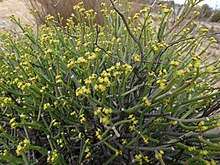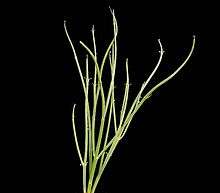Euphorbia rhombifolia
Euphorbia rhombifolia is a species of Euphorbia indigenous to Namibia and South Africa, where it is widespread in clay-rich soils, extending as far east as Kwazulu-Natal.[1]
| Euphorbia rhombifolia | |
|---|---|
 | |
| Scientific classification | |
| Kingdom: | Plantae |
| Clade: | Tracheophytes |
| Clade: | Angiosperms |
| Clade: | Eudicots |
| Clade: | Rosids |
| Order: | Malpighiales |
| Family: | Euphorbiaceae |
| Genus: | Euphorbia |
| Species: | E. rhombifolia |
| Binomial name | |
| Euphorbia rhombifolia Boiss | |
Description

It grows to 60 or 70cm in height, with a tuberous root-system that is often eaten by porcupines, and with thin (3-5mm), erect, grey, branching stems. The branches are dichotomous and taper to soft points.
The plants in the south-western Cape (E. caterviflora) are smaller, reaching only 30cm in height.
The leaves are small (1-3mm), dark, triangular and deciduous. The flowerheads are also small (3mm) and appear from winter into spring. [2]
Related species
This species is part of a group of closely related "stick euphorbias" including Euphorbia burmannii and Euphorbia tenax, which are widespread across southern Africa.[3]
| Wikimedia Commons has media related to Euphorbia rhombifolia. |
References
- http://redlist.sanbi.org/species.php?species=574-311
- Vlok, J. and Schutte-Vlok, A.L. (2010) Plants of the Klein Karoo. Umdaus Press, Hatfield.
- Bruyns, P.V. (2012). Nomenclature and typification of southern African species of Euphorbia. Bothalia 42(2): 217-245.